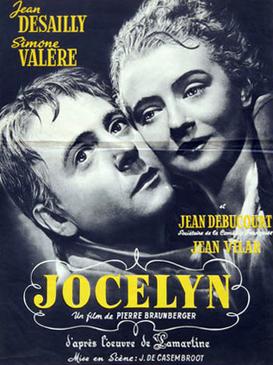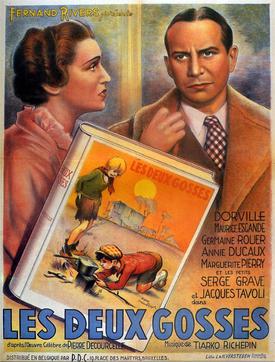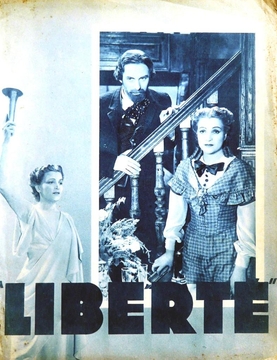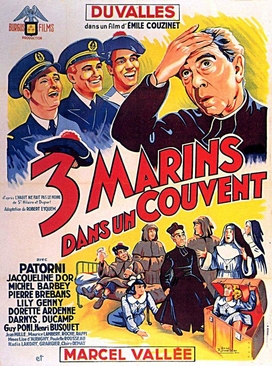
Jocelyn is a 1952 French historical drama film directed by Jacques de Casembroot and starring Jean Desailly, Simone Valère and Jean Vilar. It is set during the French Revolution. It is based on the 1836 novel of the same title by Alphonse de Lamartine, which had previously been made into a 1933 film.

The Man with a Broken Ear is a 1935 French drama film directed by Robert Boudrioz and starring Thomy Bourdelle, Jacqueline Daix and Alice Tissot. It was an adaptation of the 1862 novel by Edmond About. The film's sets were designed by the art director Maurice Cloche.

Her Last Part or Her Final Role is a 1946 French drama film directed by Jean Gourguet and starring Gaby Morlay, Jean Debucourt and Marcel Dalio. A top actress discovers that she is seriously ill.

Roger la Honte is a 1933 French historical drama film directed by Gaston Roudès and starring Constant Rémy, Germaine Rouer and France Dhélia. It is an adaptation of the 1886 novel of the same name by Jules Mary. The film's sets were designed by the art director Claude Bouxin.

As Long as I Live is a 1946 French-Italian drama film directed by Jacques de Baroncelli and starring Edwige Feuillère, Jacques Berthier and Jean Debucourt. The film's sets were designed by the art director Guy de Gastyne.
Mistigri is a 1931 French drama film adapted by Marcel Achard from his play of the same name. It was directed by Harry Lachman and stars Madeleine Renaud, Noël-Noël and Jean Debucourt. It was made at the Joinville Studios by the French subsidiary of Paramount Pictures.
Jacqueline Daix (1914–1982) was a French film actress.
The Flame is a 1926 French silent drama film directed by René Hervil and starring Germaine Rouer, Charles Vanel and Henry Vibart. It was remade as a sound film in 1936.
The Ladies in the Green Hats is a 1929 French silent comedy film directed by André Berthomieu and starring Gabrielle Fontan, René Lefèvre and Alice Tissot. It is based on the novel of the same name by Germaine Acremant.
The Bread Peddler is a 1923 French silent drama film directed by René Le Somptier and starring Suzanne Desprès, Gabriel Signoret and Geneviève Félix. It is based on Xavier de Montépin's novel of the same title.

The Drunkard is a 1953 French drama film directed by Georges Combret and starring Pierre Brasseur, Monique Mélinand and François Patrice. It was shot at the Billancourt Studios in Paris. The film's sets were designed by the art director Marcel Magniez. It is based on the 1898 novel of the same title by Jules Mary which had previously been made into a 1921 silent film The Drunkard and a 1937 sound film The Drunkard.

The Two Boys is a 1936 French drama film directed by Fernand Rivers. It is based on the 1880 novel of the same name by Pierre Decourcelle, which had previously been made into a silent film The Two Boys.
The King of Paris is a 1923 French silent film directed by Maurice de Marsan and Charles Maudru and starring Jean Dax, Suzanne Munte and Germaine Vallier. The film was remade in 1930.

Germaine Rouer (1897–1994) was a French stage and film actress. She was a member of the Comédie-Française.

Sapho is a 1934 French drama film directed by Léonce Perret and starring Mary Marquet, Jean-Max and Marcelle Praince.

Cousin Bette is a 1928 French silent historical drama film directed by Max de Rieux and starring Germaine Rouer, Henri Baudin and Alice Tissot. It is based on the 1846 novel Cousin Bette by Honoré de Balzac.

Boulot the Aviator is a 1937 French comedy film directed by Maurice de Canonge and starring Robert Arnoux, Michel Simon and Marguerite Moreno. It was based on the 1932 novel Aventures cocasses de Boulot, aviateur by Georges de La Fouchardière and Alain Laubreaux.

Liberty is a 1938 historical biographical drama film directed by Jean Kemm and starring Maurice Escande, Lucien Gallas and Milly Mathis. The film's sets were designed by the art director Claude Bouxin. It is based on the life of Auguste Bartholdi, a sculptor best known for creating the Statue o.

My Priest Among the Rich is a 1952 French comedy film directed by Henri Diamant-Berger and starring Yves Deniaud, Robert Arnoux and Raymond Bussières. It was shot at the Neuilly Studios in Paris. The film's sets were designed by the art director Roger Briaucourt. It is based on the 1923 novel of the same title by Clément Vautel, which has been made into films several times. It was followed by a sequel My Priest Among the Poor , also directed by Diamant-Berger, in 1956.

Three Sailors in a Convent is a 1950 French comedy film directed by Émile Couzinet and starring Frédéric Duvallès, Raphaël Patorni and Jacqueline Dor. The film's sets were designed by the art director Serge Renetteau.














